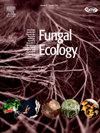Detailed analysis of fungal communities in Norway spruce logs reveals stochastic fine-scale patterns of species and detects lichen forming fungi without their photobionts
IF 2.2
3区 环境科学与生态学
Q3 ECOLOGY
引用次数: 0
Abstract
Fungal ecologists have long been intrigued by the mechanisms behind the high fungal species richness in dead wood at small and large spatial scales. We identified processes resulting in fine-scale fungal community patterns with a network analysis based on a detailed metabarcode mapping of fungi in and on the surfaces of eight naturally fallen Norway spruce logs in northern Sweden. Our results show that (1) dominant species and communities of fungi vary significantly among the logs, (2) wood inside and on log surfaces has distinct and diverse fungal compositions and (3) consistent co-occurrences of fungi in wood are rare. These patterns suggest priority effects favouring primary colonizing species are important for determining which becomes the dominant species, and that colonization of the rest of the community and fungal co-occurrences are largely shaped by stochastic processes. Furthermore, lichen-forming fungi were detected without their photobionts in wood, indicating possible free-living stages.
对挪威云杉原木真菌群落的详细分析揭示了物种的随机精细模式,并检测了没有光生物的地衣形成真菌
真菌生态学家长期以来一直对小尺度和大尺度枯木中真菌物种丰富度高背后的机制感兴趣。我们通过网络分析确定了导致精细尺度真菌群落模式的过程,该网络分析基于瑞典北部八棵自然倒下的挪威云杉原木表面和内部真菌的详细元条形码图谱。结果表明:(1)不同原木间真菌的优势种和群落差异显著;(2)木材内部和表面真菌组成明显多样;(3)真菌在木材中一致共现的情况很少。这些模式表明,有利于主要定殖物种的优先效应对于决定哪一个成为优势物种很重要,并且群落其余部分的定殖和真菌共同出现在很大程度上是由随机过程形成的。此外,在木材中检测到没有光生物的地衣形成真菌,表明可能存在自由生活阶段。
本文章由计算机程序翻译,如有差异,请以英文原文为准。
求助全文
约1分钟内获得全文
求助全文
来源期刊

Fungal Ecology
环境科学-生态学
CiteScore
5.80
自引率
3.40%
发文量
51
审稿时长
3 months
期刊介绍:
Fungal Ecology publishes investigations into all aspects of fungal ecology, including the following (not exclusive): population dynamics; adaptation; evolution; role in ecosystem functioning, nutrient cycling, decomposition, carbon allocation; ecophysiology; intra- and inter-specific mycelial interactions, fungus-plant (pathogens, mycorrhizas, lichens, endophytes), fungus-invertebrate and fungus-microbe interaction; genomics and (evolutionary) genetics; conservation and biodiversity; remote sensing; bioremediation and biodegradation; quantitative and computational aspects - modelling, indicators, complexity, informatics. The usual prerequisites for publication will be originality, clarity, and significance as relevant to a better understanding of the ecology of fungi.
 求助内容:
求助内容: 应助结果提醒方式:
应助结果提醒方式:


